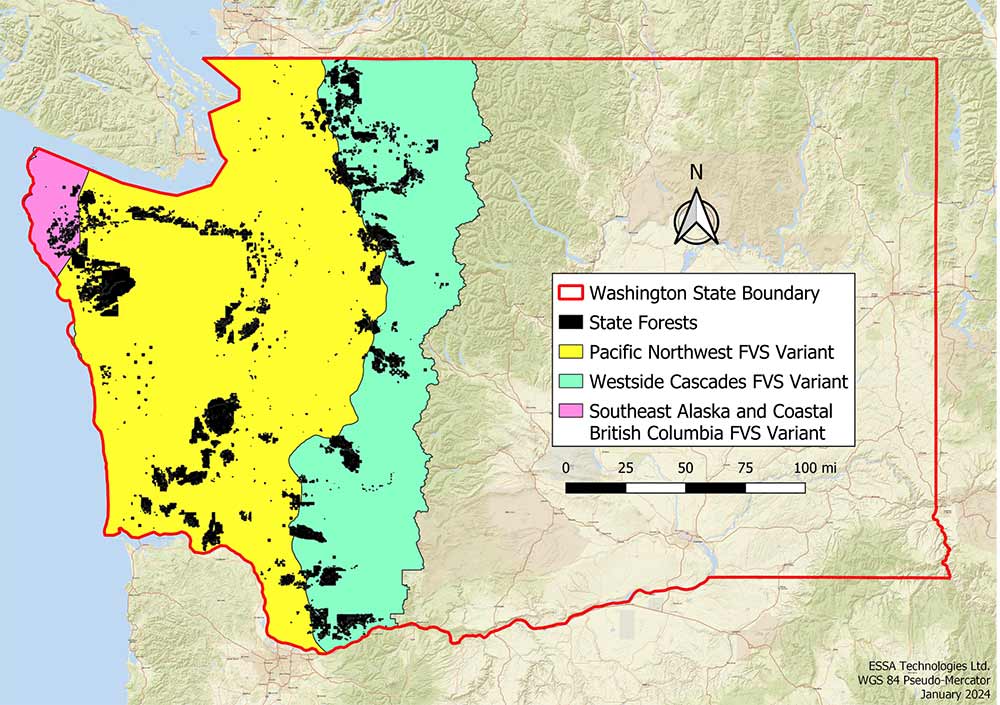Forest Carbon Quantification for Washington Department of Natural Resources Managed Lands
Photo credit: USFWS: Brent Lawrence. “Diablo Lake in the Northern Cascades” Flickr, 3 November 2023
Project Details
Location: |
Washington State | |
Client: |
Washington Department of Natural Resources | |
Duration: |
January 2024 – June 2025 | |
Team Member(s): |
Cedar Morton, Frank Poulsen, Don Robinson, Alexandra Tekatch, Ira Sutherland, Graham Mushet, Jessica Castellanos-Labarcena | |
Practice Area(s): |
Nature Based Solutions | |
Services Employed: |
Ecological modelling, GIS analysis, Natural asset planning and decision support, Strategic planning and policy analysis, Facilitation and engagement, Science communication |
The Problem We Aimed to Solve
In its 2023 legislative session, the Washington State Legislature directed DNR to establish a work group (the “Work Group”) to examine the relationship between forest management and atmospheric carbon sequestration (absorption) and storage in DNR-managed forests. The Work Group was tasked with developing approaches to the conservation and management of older, carbon-dense, structurally complex forests, increasing carbon sequestration and storage in these forests and in harvested wood products, generating predictable beneficiary revenue, maintaining timber supplies that support local industry, and addressing economic needs in rural communities.
This work was funded by a proviso (the “Proviso”) in the 2023 Capital Budget (c 474 §3130 3), which allocated $2.5 million to convene the Work Group and to assess the existing and future wood supply in the region, model impacts on wood supply based on different management alternatives, complete carbon accounting and quantification consistent with IPCC guidelines and emerging science, and model impacts on carbon storage and sequestration under different management alternatives. ESSA was responsible for the carbon modeling component of this work (Section b) II of the Proviso) from January 2024 – June 2025.
How We Helped
Our study explored 8 forest management scenarios with and without climate change for a total of 16 scenarios. Each scenario was collaboratively developed with the Work Group and DNR, and then simulated using different model configurations in the Forest Vegetation Simulator (FVS). In the final report we describe each scenario, our simulation methods, and the modeled results, which estimate relative impacts of each scenario on carbon and timber harvest compared to current DNR management practices.
Our Project’s Impacts
The Pacific Northwest is a naturally carbon-rich ecoregion, with substantial aboveground carbon volumes, especially west of the Cascade Crest. This ecoregion stores more than twice the carbon of the East Cascades and exceeds carbon storage in the Midwest and Northeast states.
Accurate carbon quantification is valuable for assessing the region’s contribution to global carbon cycling, making informed conservation decisions that support sustainable land management, and ensuring trust beneficiaries of DNR-managed forest lands obtain the greatest benefits from these lands. Carbon accounting serves as a foundation for developing effective forest management and climate change mitigation strategies, supports safeguarding biodiversity by identifying key habitats, improves our understanding the long-term health and resilience of these ecosystems to support their management, and supports the sale and trading of carbon in established carbon markets.
-
Project currently in-progress. See WA DNR’s public project portal here.


